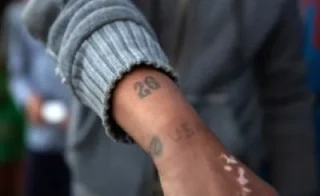Numbers Gangs: Violent Gang Culture in Cape Flats
In The first six months of 2019 there were 1,000 murders caused by three prison gangs in Cape Flats South Africa.
In the first six months of 2019, a shocking and devastating reality unfolded on the streets of Cape Flats. During this period, an alarming number of over 1,000 murders occurred, primarily attributed to the nefarious influence of a network of three prison gangs known as the Numbers Gangs.
 |
| Member of the 26s, also known as the Americanos. |
Cape Flats is a sprawling low-income slum located near Cape Town, South Africa known for its high levels of unemployment rate at 50%. The area is also known to be a crime hotspot, with gang-related crimes being a regular occurrence. The rate of poverty is one of the highest in the country with 45.9% of people living on less than $65 per month in 2019.
Over the years, particular violent prison gangs have made their way into the social, political, and racial dynamic of the Cape Flats community and have contributed to the rise and persistence of violent gang activity in this area.
Mfuleni is one of the newest and poorest townships in Cape Flats, nearly 60,000 people live in these informal slum settlements on the outskirts. Mfuleni was established in the late 1990s as a result of fires and floods that displaced thousands of people from other townships. Mfuleni faces many challenges, such as murder, gangs, and drug abuse. The most common drugs are heroin and crystal meth, locally known as Tik.
The Numbers Gangs of Cape Flats; 26s, 27s, and 28s.
There are three major gangs in Cape Flats named 26s, 27s, and 28s. These are the Numbers Gangs, also known as the Nummies. They are a group of prison gangs that originated within the South African prison system.
There are three main Numbers Gangs in South Africa:
- The 26s, also known as the Americanos was used to refer to mixed-race prisoners.
- The 27s also referred to as the Ghos'boys or Ghosts, did consist of African prisoners.
- The 28s, also known as the Bosmont Boys or Mongrels, were white prisoners.
The term Number Gangs is used to refer to highly organized prison gangs that originated within the prison system but have expanded their influence beyond the confines of correctional facilities. These gangs, namely the 26s, 27s, and 28s, have a very organized power structure and engage in criminal activities both inside and outside of prison, contributing to the overall gang culture in Cape Flats.
Origin and History of the Number Gangs in Cape Flats.
The origin and history of the Number Gangs in Cape Flats, South Africa can be traced back to the early 20th century within the country's prison system. These gangs, known as the 26s, 27s, and 28s, have a long and complex history that intertwines with the social, political, and racial dynamics of the time.
During the apartheid era, South Africa's prison system became a site of intense racial segregation and oppression. Political prisoners, activists, and individuals deemed a threat to the apartheid regime were often incarcerated together. Within this environment, prisoners organized themselves along racial and ethnic lines for protection and solidarity.
The Number Gangs emerged as a response to the harsh conditions and racial divisions within the prisons. Each gang was originally formed along ethnic lines, offering support, protection, and a sense of belonging to its members. The gangs were also influenced by existing criminal organizations and hierarchical structures that existed within the prisons.
Numbers Gangs Explained.
The 26s, also known as the Americanos, is one of the prominent Numbers Gangs. The name Americanos is a that nickname drew inspiration from American gangster culture and is sometimes used to refer to the 26s. The gang originated in the Western Cape Province and has a strong presence in prisons, particularly in Cape Town. The 26s are primarily made up of individuals from Coloured mixed-race backgrounds. They became known for their involvement in criminal activities such as robbery, drug trafficking, and extortion.
The 27s are sometimes referred to as the Ghos'boys or Ghosts. It was formed in the Gauteng Province, specifically in Johannesburg's prisons. The 27s initially comprised predominantly Black African inmates. They were characterized by their strict code of conduct and their focus on power, respect, and unity. Over time, the 27s expanded to include members from other racial backgrounds.
The 28s, also known as the Bosmont Boys. This name refers to the Bosmont area in Johannesburg, which is associated with the origin and presence of the 28s gang. It was founded in Gauteng Province, originating in Johannesburg's prisons. The 28s primarily consist of White inmates, including both English-speaking and Afrikaans-speaking members. The 28s had a reputation for being highly organized and disciplined, often involved in organized crime and illicit activities.
Number Gangs expanded beyond the prison walls.
As time went on, the Number Gangs expanded beyond the prison walls, establishing a presence in the communities of Cape Flats and other areas. Gang members who were released from prison often continued their criminal activities, recruiting new members and perpetuating the influence of the gangs.
Prison gangs use intimidation, violence, and threats to maintain control over their operations in Cape Flats. They enforce their rules and punish those who disobey or interfere with their activities. However, the influence of prison gangs is not limited to the confines of the prison. These gangs often have connections to criminal organizations on the outside. These connections enable them to continue their illegal operations even after their members are released from prison.
Once released, gang members can use their established networks to distribute drugs and engage in other criminal activities developing their own codes, rituals, and language, which became part of their distinctive subculture. The gangs also had a strict hierarchy, with leaders known as generals and field marshals who held significant power and influence within the gang structure.
While the Number Gangs originally formed along racial lines, over the years, these boundaries have become blurred, and the gangs have become more diverse in terms of membership. Today, the gangs' activities continue to contribute to the cycle of violence, drug abuse, and criminality in the communities of Cape Flats.









